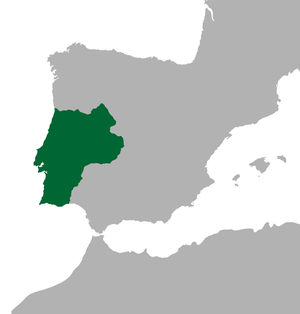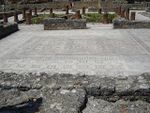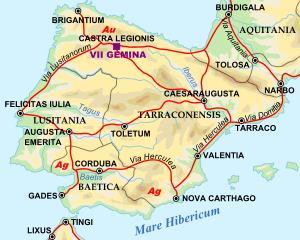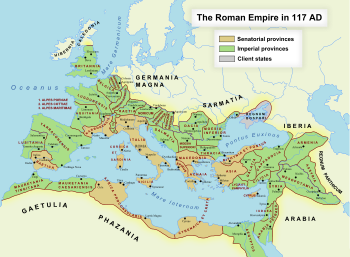Lusitania

Lusitania (Portuguese: Lusitania) was an ancient Roman province including approximately all of modern Portugal south of the Douro river and part of modern Spain (the present autonomous community of Extremadura and a small part of the province of Salamanca). It was named after the Lusitani or Lusitanian people (an Indo-European people). Its capital was Emerita Augusta (currently Mérida, Spain), and it was initially part of the Roman Republic province of Hispania Ulterior, before becoming a province of its own in the Roman Empire.
Contents |
Pre-Roman Lusitania
Strabo in his Geography mentions that the ancient people, also called Lusitani to the lands north of river Douro, the land that in his own time was known as Gallaecia.[1]
Origin of the name
The etymology of Lusitania, like the origin of the Lusitani who gave the province their name, is unclear. The name may be of Celtic origin: Lus and Tanus, "tribe of Lusus".
The name may derive from Lucis, an ancient people mentioned in Ora Maritima and Tan, from Celtic Tan (Stan), or Tain, meaning a region or implying a country of waters, a root word that formerly meant a prince or sovereign governor of a region. [2][3][4] The name has been connected with the personal Celtic name Luso and with the god Lugh.[5]
Ancient Romans, such as Pliny the Elder (Natural History, 3.5) and Varro (cited by Pliny), speculated that the name Lusitania was of Roman origin, as when Pliny says lusum enim liberi patris aut lyssam cum eo bacchantium nomen dedisse lusitaniae et pana praefectum eius universae: that Lusitania takes its name from the lusus associated with Bacchus and the lyssa of his Bacchantes, and that Pan is its governor. Lusus is usually translated as "game" or "play", while lyssa is a borrowing from the Greek λυσσα, "frenzy" or "rage", and sometimes rage personified; for later poets, Lusus and Lyssa become flesh-and-blood companions of Bacchus. Luís de Camões' Os Lusíadas, which portrays Lusus as the founder of Lusitania, extends these ideas, which have no connection with modern etymology.
Lusitanians
The Lusitani, who were Indo-Europeans and may have come from the Alps, established themselves in the region in the 6th century BC, but historians and archeologists are still undecided about their origins. Some modern authors consider them to be an indigenous people who were Celticized culturally and possibly genetically through intermarriage.
The archeologist Scarlat Lambrino defended the position that the Lusitanians were a tribal group of Celtic origin related to the Lusones (a tribe that inhabited the east of Iberia). Possibly, both tribes came from the Swiss mountains. But some prefer to see the Lusitanians as a native Iberian tribe, resulting from intermarriage between different tribes.
The first area colonized by the Lusitani was probably the Douro valley and the region of Beira Alta (present day Portugal); in Beira, they stayed until they defeated the Celtici and other tribes, then they expanded to cover a territory that reached Estremadura before the arrival of the Romans.
War against Rome
|
|||||
| History of Portugal series |
|---|
|
| Topics |
|
| Timeline of Portuguese history |
| “ | And yet the country north of the Tagus, Lusitania, is the greatest of the Iberian nations, and is the nation against which the Romans waged war for the longest times—Strabo[7] | ” |
The Lusitani are mentioned for the first time in Livy (218 BC) and are described as fighting for the Carthaginians; they are reported as fighting against Rome in 194 BC, sometimes allied with other Celtiberian tribes.
In 179 BC, the praetor Lucius Postumius Albinus celebrated a triumph over the Lusitani, but in 155 BC, on the command of Punicus (Πουνίκου) first and Cesarus (Καίσαρος) after, the Lusitani reached Gibraltar. Here they were defeated by the praetor Lucius Mummius.
Servius Sulpicius Galba organised a false armistice, but while the Lusitani celebrated this new alliance, he massacred them, selling the survivors as slaves; this caused a new rebellion led by Viriathus, who was soon killed by traitors paid by the Romans in 139 BC, after having led a successful guerrilla campaign against Rome and their local allies. Romans scored other victories with proconsul Decimus Junius Brutus Callaicus and Gaius Marius (113 BC), but still the Lusitani resisted with a long guerilla war; they later joined Sertorius' (a renegade Roman General) troops and were finally defeated by Augustus.
From 152 BC onwards, the Roman Republic had difficulties in recruiting soldiers for the wars in Hispania, deemed particularly brutal.
Read more at Timeline of Portuguese history (Pre-Roman).
Roman province


With Lusitania (and Asturia and Gallaecia), Rome had completed the conquest of the Iberian peninsula, which was then divided by Augustus (25–20 BC) into the eastern and northern Hispania Tarraconensis, the southwestern Hispania Baetica and the western Provincia Lusitana. Originally, Lusitania included the territories of Asturia and Gallaecia, but these were later ceded to the jurisdiction of the new Provincia Tarraconensis and the former remained as Provincia Lusitania et Vettones. Its northern border was along the Douro river, while on its eastern side its border passed through Salmantica and Caesarobriga to the Anas (Guadiana) river.
The capital of Lusitania was Augusta Emerita (currently Mérida) in Spain. Modern Coimbra was the Roman city of Aeminium, and near modern Condeixa-a-Nova was the Roman city of Conímbriga. Conímbriga was not the largest city of Lusitania, but it is the best preserved. Built on a long-inhabited site, it was sacked by the Suevi in 468 and its inhabitants fled to Aeminium, which inherited its name and is nowadays known as Coimbra. Conímbriga's city walls are largely intact, and the mosaic floors (illustration, left) and foundations of many houses and public buildings remain. In the baths, visitors can view the network of stone heating ducts (the hypocaust) beneath the now-missing floors. Archaeologists estimate that, though excavations began in 1898, only 10% of the city has been excavated.
Under Diocletian, Lusitania kept its borders and was ruled by a praeses, later by a consularis; finally, in 298 AD, it was united with the other provinces to form the Diocesis Hispaniarum ("Diocese of the Hispanias").
Notable Lusitanians
- Viriathus
- Gaius Appuleius Diocles
Portuguese use of the name
As with the Roman names of many European countries, Lusitania was and is often used as an alternative name for Portugal, especially in formal and literary or poetic contexts. The 16th century colony, which would develop into Brazil, was named Nova Lusitânia ("New Lusitania"). In common use are such terms as Lusophone, meaning Portuguese-speaking, and Lusitanic, referring to the Community of Portuguese Language Countries — once Portugal's colonies and presently independent countries still sharing some common heritage.
See also
- Lusitanians
- Lusitanian mythology
- Lusitanian language
- Ophiussa
- Portugal
- History of Portugal
- Timeline of Portuguese history
- Pre-Roman Western Iberia (Before the 3rd Century BC)
- Roman Lusitania and Gallaecia (3rd Century BC to 4th Century AC)
- Pre-Roman peoples of the Iberian Peninsula
- Balsa (Roman town)
References
- ↑ "Strabo, Geography, Book III, Chapter 4". Penelope.uchicago.edu. http://penelope.uchicago.edu/Thayer/E/Roman/Texts/Strabo/3D*.html. Retrieved 2010-08-03.
- ↑ "''An Universal History From the Earliest Account of Time'', 1747, p. 22". Books.google.com. http://books.google.com/books?id=boIBAAAAQAAJ&pg=PA22&dq=celtic+tan&as_brr=3#PPA22,M1. Retrieved 2010-08-03.
- ↑ "Charles Vallancey, ''Collectanea de Rebus Hibernicis'', V.6, pt.1, 1786, p.279". Books.google.com. http://books.google.com/books?id=z3WsOrbjfh4C&pg=PA279&dq=celtic+tan&lr=&as_brr=3#PPA279,M1. Retrieved 2010-08-03.
- ↑ "Edward Lhuyd & John O'Brien, ''Focalóir gaoidhilge-sax-bhéarla, or An Irish-English dictionary'', 1768, p. 464". Books.google.com. http://books.google.com/books?id=C30CAAAAQAAJ&pg=RA2-PA464&dq=celtic+tan+tain+prince&lr=&as_brr=3. Retrieved 2010-08-03.
- ↑ "Room,Adrian. Placenames of the World. pg 228". Books.google.com. http://books.google.com/books?id=M1JIPAN-eJ4C&printsec=frontcover&dq=Placenames+of+the+World:+Origins+and+Meanings+of+the+Names+for+6,600+...+By+Adrian+Room&sig=bPqZQvDFUdcHLia8GHNknRwreuk. Retrieved 2010-08-03.
- ↑ "Ethnographic Map of Pre-Roman Iberia (circa 200 b". Arkeotavira.com. http://arkeotavira.com/Mapas/Iberia/Populi.htm. Retrieved 2010-08-03.
- ↑ "Strabo.Geography". Penelope.uchicago.edu. http://penelope.uchicago.edu/Thayer/E/Roman/Texts/Strabo/3C*.html. Retrieved 2010-08-03.
External links
|
|||||||
| Western Empire (395–476) | |||
|---|---|---|---|
| Praetorian Prefecture of Gaul |
Diocese of Gaul: Alpes Poeninae et Graiae • Belgica I • Belgica II • Germania I • Germania II • Lugdunensis I • Lugdunensis II • Lugdunensis III • Lugdunensis IV • Maxima Sequanorum Diocese of Vienne (later Septem Provinciae): Alpes Maritimae • Aquitanica I • Aquitanica II • Narbonensis I • Narbonensis II • Novempopulania • Viennensis Diocese of Spain: Baetica • Baleares • Carthaginensis • Gallaecia • Lusitania • Mauretania Tingitana • Tarraconensis Diocese of Britain: Britannia I • Britannia II • Flavia Caesariensis • Maxima Caesariensis • Valentia (369) |
||
| Praetorian Prefecture of Italy |
Diocese of Suburbicarian Italy: Apulia et Calabria • Bruttia et Lucania • Campania • Corsica • Picenum Suburbicarium • Samnium • Sardinia • Sicilia • Tuscania et Umbria • Valeria Diocese of Annonarian Italy: Alpes Cottiae • Flaminia et Picenum Annonarium • Liguria et Aemilia • Raetia I • Raetia II • Venetia et Istria Diocese of Africa†: Africa proconsularis (Zeugitana) | Byzacena • Mauretania Caesariensis • Mauretania Sitifensis • Numidia Cirtensis • Numidia Militiana • Tripolitania Diocese of Pannonia (later of Illyricum): Dalmatia • Noricum mediterraneum • Noricum ripense • Pannonia I • Pannonia II • Savia • Valeria ripensis |
||
| Eastern Empire (395–ca. 640) | |||
| Praetorian Prefecture of Illyricum |
Diocese of Dacia: Dacia Mediterranea • Dacia Ripensis • Dardania • Moesia I • Praevalitana Diocese of Macedonia: Achaea • Creta • Epirus nova| Epirus vetus | Macedonia I • Macedonia II Salutaris • Thessalia |
||
| Praetorian Prefecture of the East |
Diocese of Thrace: Europa • Haemimontus • Moesia II§ • Rhodope • Scythia§ • Thracia Diocese of Asia*: Asia • Caria§ • Hellespontus • Insulae§ • Lycaonia (370) • Lycia • Lydia • Pamphylia • Pisidia • Phrygia Pacatiana • Phrygia Salutaria Diocese of Pontus*: Armenia I* • Armenia II* • Armenia Maior* • Armenian Satrapies* • Armenia III (536) • Armenia IV (536) • Bithynia • Cappadocia I* • Cappadocia II* • Galatia I* • Galatia II Salutaris* • Helenopontus* • Honorias* • Paphlagonia* • Pontus Polemoniacus* Diocese of the East: Arabia • Cilicia I • Cilicia II • Cyprus§ • Euphratensis • Isauria • Mesopotamia • Osroene • Palaestina I • Palaestina II • Palaestina III Salutaris • Phoenice • Phoenice Libanensis • Syria I • Syria II Salutaris • Theodorias (528) Diocese of Egypt: Aegyptus I • Aegyptus II • Arcadia • Augustamnica I • Augustamnica II • Libya Superior • Libya Inferior • Thebais Superior • Thebais Inferior |
||
| Other territories | Taurica • Lazica (532/562) • Spania (552) | ||
| Notes | Provincial administration reformed by Diocletian, ca. 293. Praetorian prefectures established after the death of Constantine I. Empire permanently partitioned after 395. Exarchates of Ravenna and Africa established after 584. After massive territorial loss due to the Muslim conquests, the remaining provinces were superseded by the theme system in ca. 640–660, although they survived under the latter until the early 9th century * affected (boundaries modified/abolished/renamed) by Justinian's administrative reorganization in 534–536 † re-established after reconquest by the Eastern Empire in 534, as the separate praetorian prefecture of Africa § joined together into the Quaestura exercitus in 536 |
||

